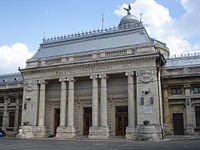- Great National Assembly
-
Great National Assembly
Marea Adunare NaţionalăType Type Unicameral Timeline Country Romanian People's Republic (1948-1966)
Socialist Republic Romania (1966-1989)Established 1948 Preceded by Romanian: Reprezentanţa Naţionalǎ1 (Adunarea Deputaţilor2) Succeeded by Parliament of Romania (Chamber of Deputies and the Senate) Disbanded 1989 Members 369 Election Voting system open single party list Meeting place 
Palatul Adunǎrii Deputaţilor Footnotes 1the name under witch the Parliament of Romania was defined by the 1866 and 1923 Constitutions;
2after the war the Constitution of 1923 was reestablished; due to the communist occupation of the country the Senate was suspended;The Great National Assembly (Romanian: Marea Adunare Naţională; MAN) was the legislature of the Romanian People's Republic and the Socialist Republic Romania. When Communism was overthrown in Romania in December 1989, the National Assembly was replaced by a bicameral parliament, made up of the Chamber of Deputies and the Senate.
The Great National Assembly was elected every four years and each of its members represented 60,000 citizens. Despite of this, the Assembly was merely a façade which helped perpetuating the illusion of democracy.[1]
Contents
Powers
Its role is given by article 43 of the 1965 Constitution of Romania and it includes 24 powers, which range from changing the constitution to the naming and deposing of the Supreme Commander of the Romanian Army. The resolutions required a simple majority to be passed through.[1]
The Assembly convened twice a year for ordinary sessions and for extraordinary sessions as many times as required by the Council of State or by at least one third of the members of the Assembly. It elected its own chairmen and four deputies to preside each session.[1]
Formally, the MAN gained in power over time: the 1948 Constitution (article 39) grants it just eight powers;[2] the 1952 Constitution (article 24), 10.[3]
1980 elections
According to the official results of the March 9, 1980, election, which elected 369 deputies, 99.99% of the registered voters cast their votes. Of them, 98.52% voted for the official candidates, 1.48% voted against and just 44 votes were declared invalid.[1]
192 seats of the Assembly were occupied by women and 47 seats belonged to national minorities (mainly Hungarians and Germans).[1]
Presidents of the Great National Assembly
- Gheorghe Apostol April 7, 1948-June 11, 1948;
- Constantin Agiu June 11, 1948-December 27, 1948;
- Constantin Pîrvulescu December 27, 1948-July 5, 1949;
- Dumitru Petrescu July 5, 1949-December 28, 1949;
- Alexandru Drăghici December 28, 1949-January 26, 1950;
- Dumitru Petrescu January 26, 1950-May 29, 1950;
- Constantin Doncea May 29, 1950-September 6, 1950;
- Gheorghe Apostol September 6, 1950-April 5, 1951;
- Ion Vincze April 5, 1951-March 26, 1952;
- Gheorghe Apostol March 26, 1952-June 2, 1952;
- Gheorghe Stoica June 2, 1952-November 30, 1952
- Constantin Pîrvulescu January 23, 1953-20 March, 1961;
- Ştefan Voitec 20 March 1961-March 28, 1974;
- Miron Constantinescu March 28, 1974-18 July 1974;
- Nicolae Giosan 26 July 1974-22 December 1989.[4]
References
- ^ a b c d e Richard Staar, Communist Regimes in Eastern Europe (4th revised edition, 1984), Hoover Institution, Stanford University. pg. 193-194
- ^ 1948 Constitution of Romania
- ^ 1952 Constitution of Romania
- ^ rulers.org
Categories:- Communist Romania
- Defunct unicameral legislatures
- 1948 establishments in Romania
- 1989 disestablishments
Wikimedia Foundation. 2010.
